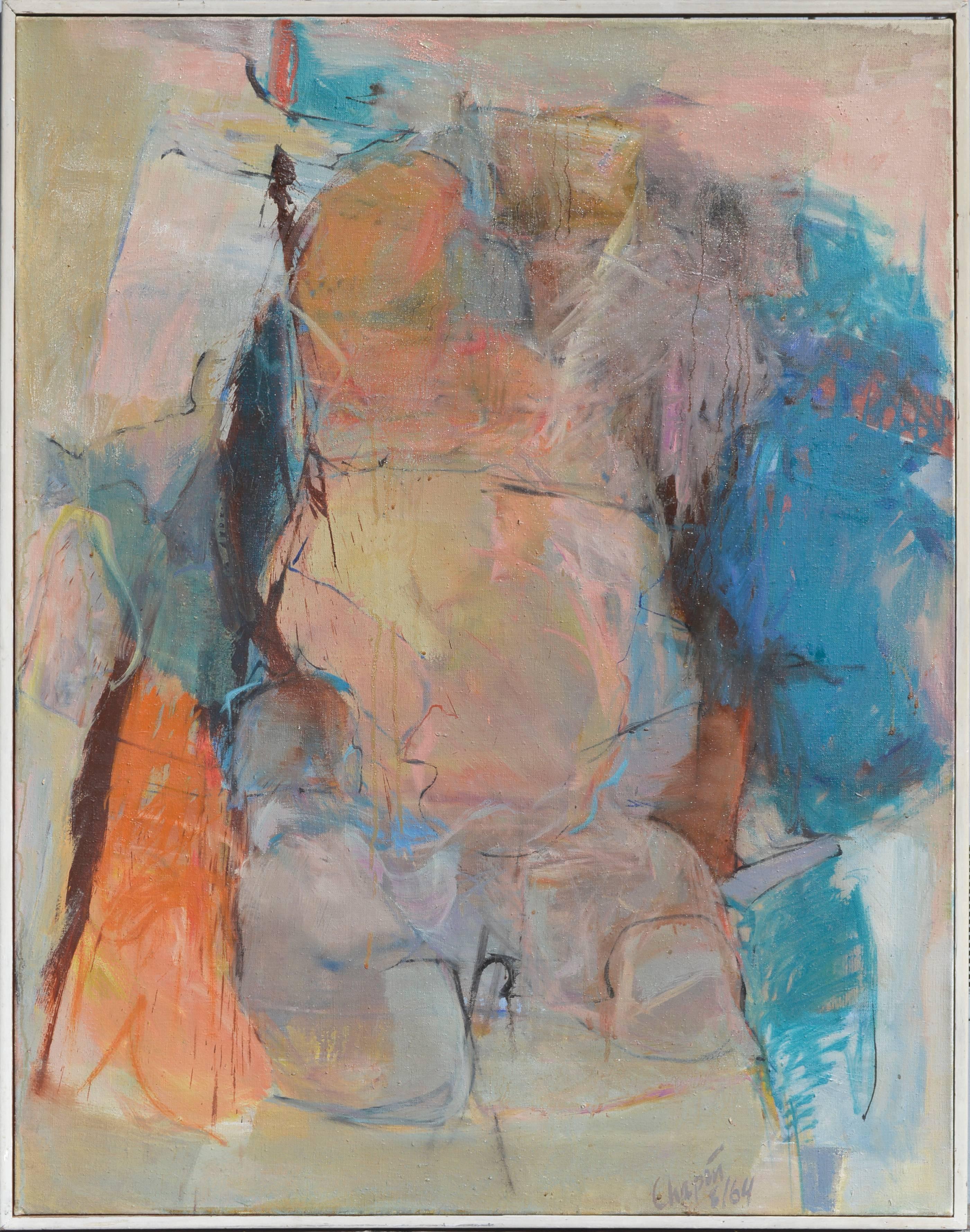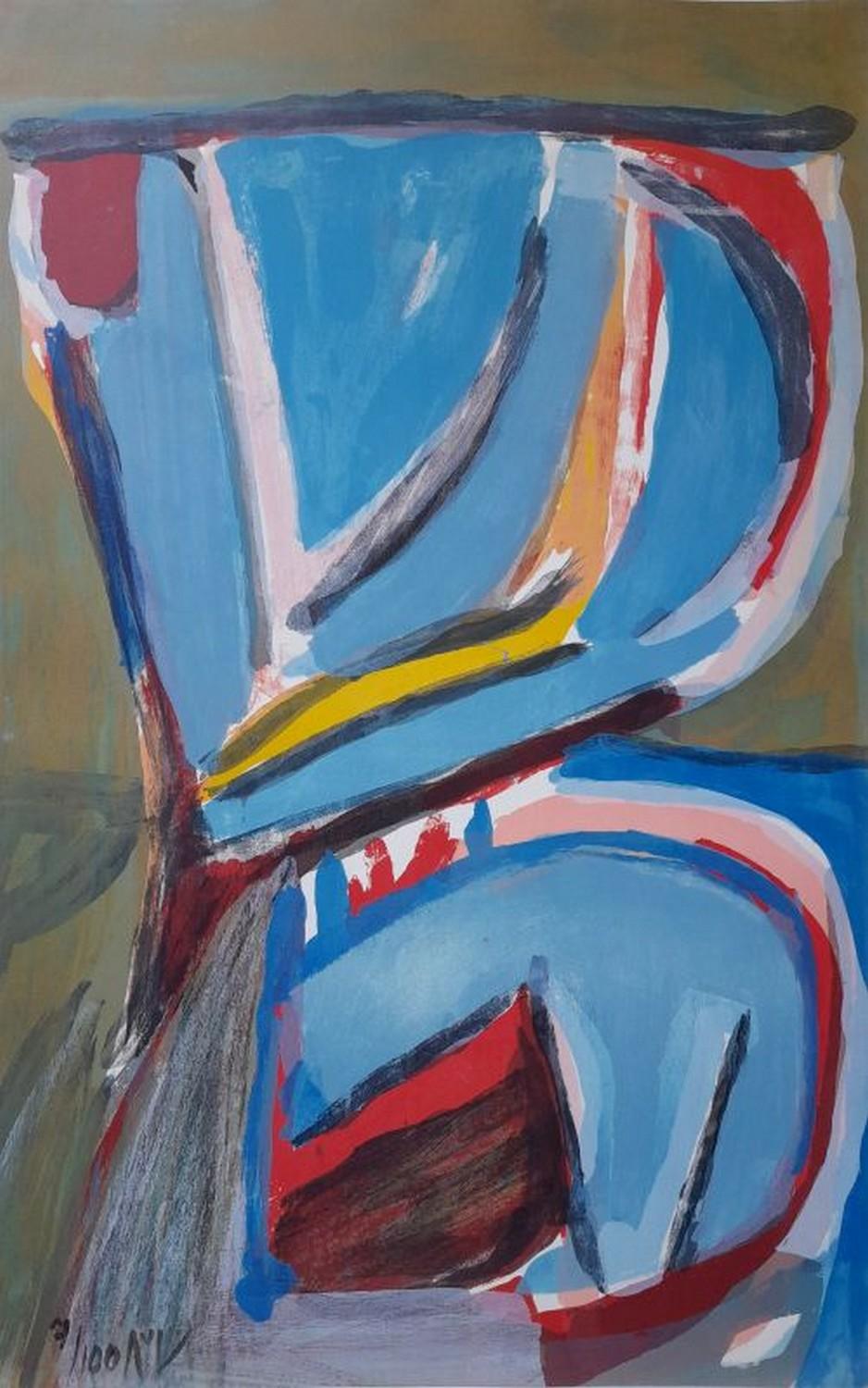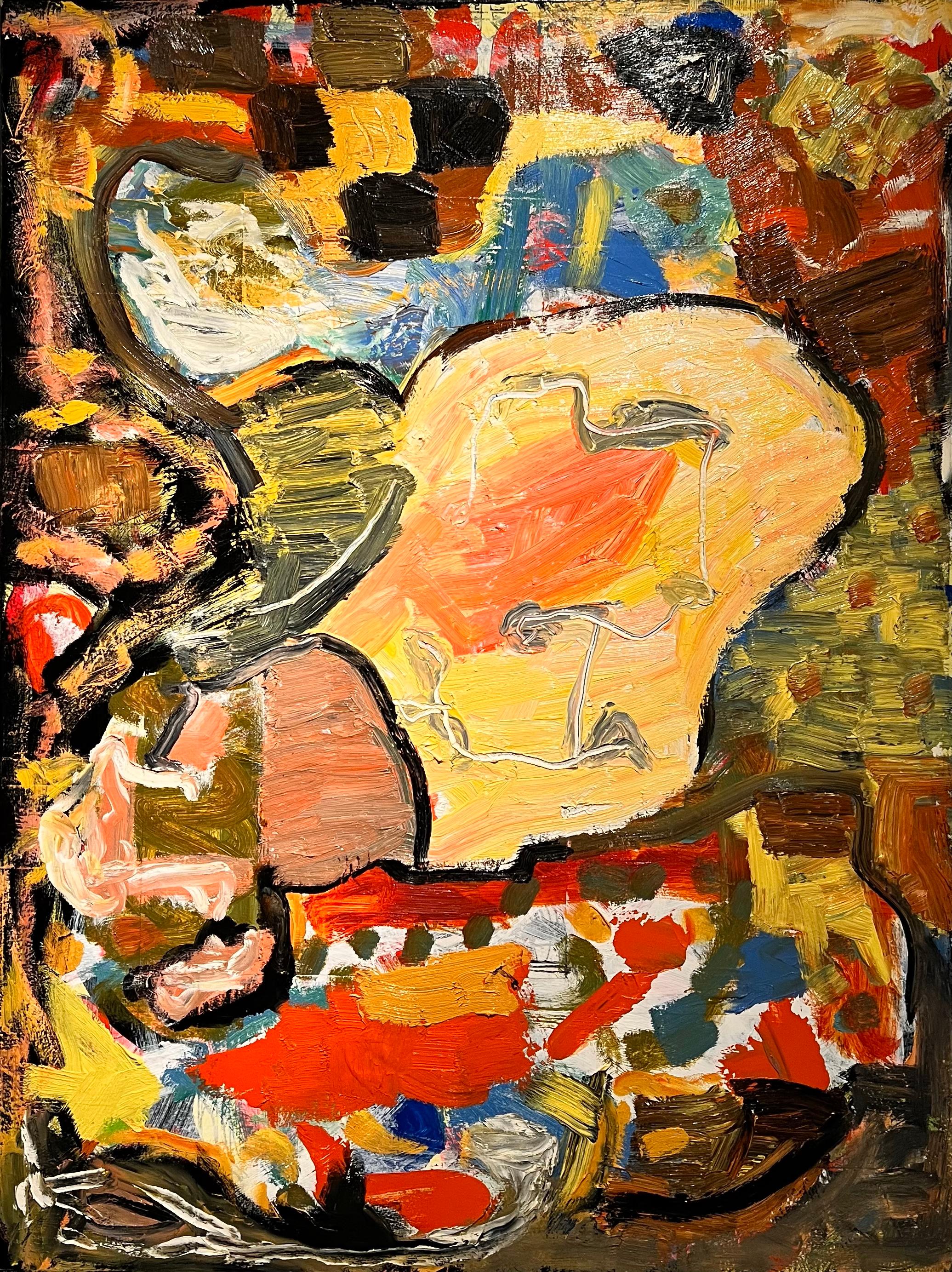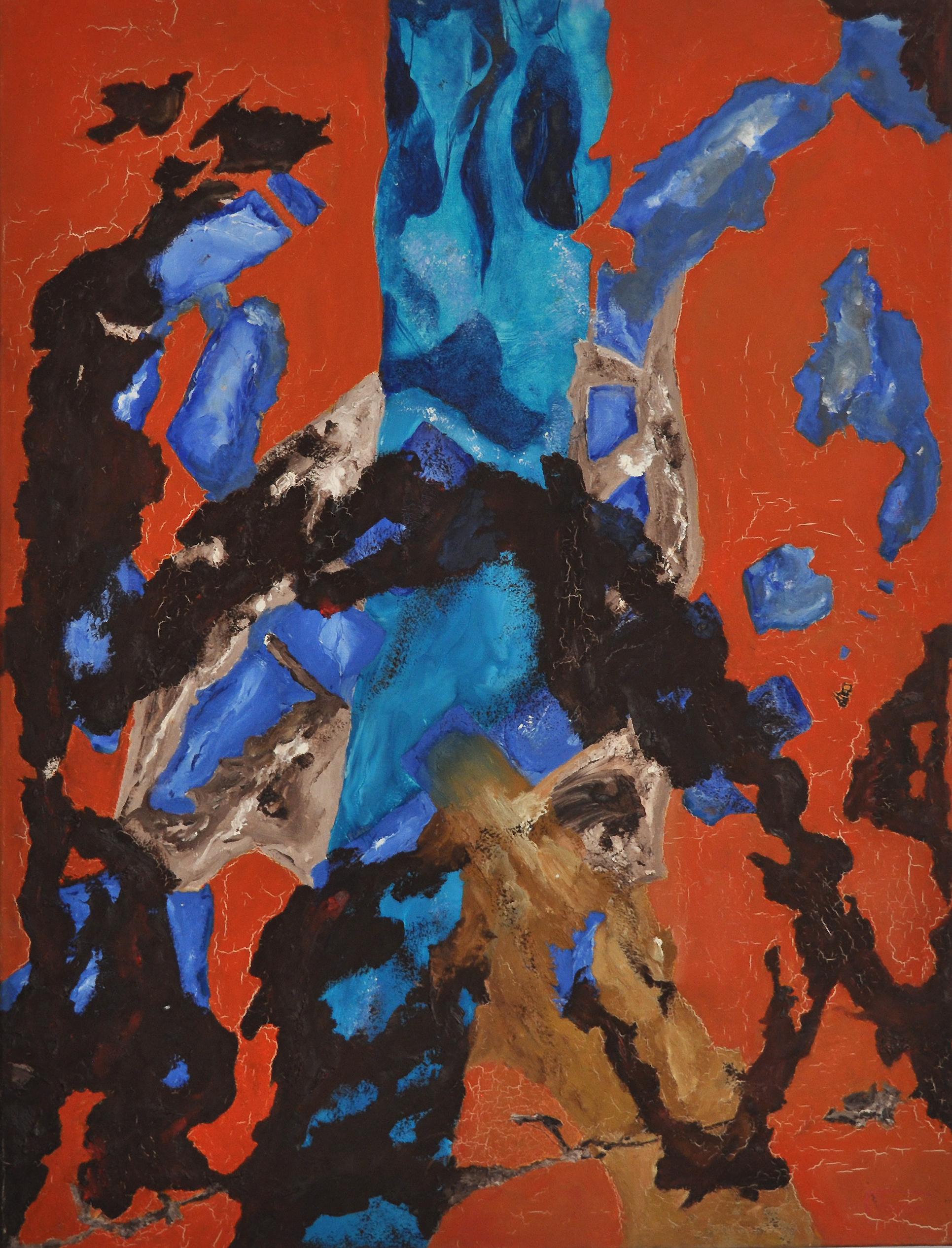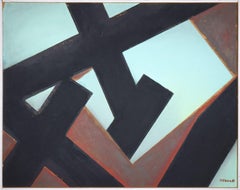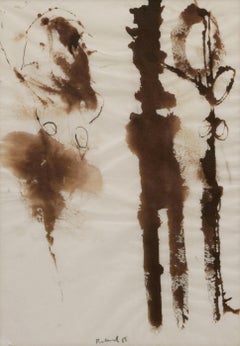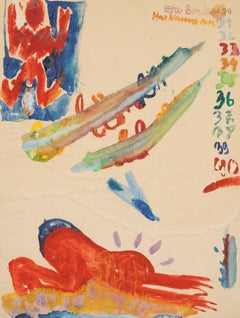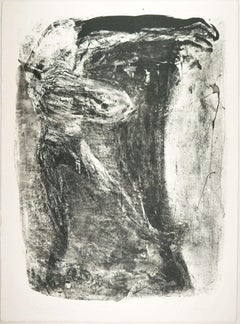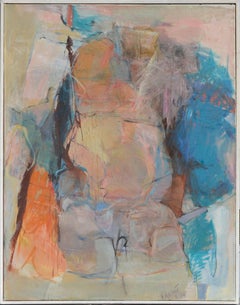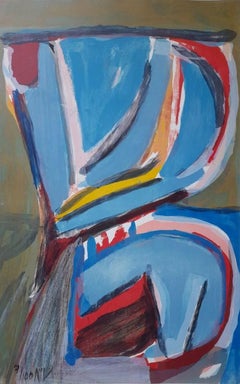Items Similar to Rare Animal / - Abstract figuration -
Want more images or videos?
Request additional images or videos from the seller
1 of 8
Veit HofmannRare Animal / - Abstract figuration -1987
1987
$933.84
£692.91
€780
CA$1,304.24
A$1,414.48
CHF 742.94
MX$17,181.36
NOK 9,296.71
SEK 8,753.37
DKK 5,939.70
About the Item
Veit Hofmann (*1944 Dresden), Rare Animal, 1987. Oil on light card, 42 cm (height) x 30 cm (width), monogrammed “V[eit]H[ofmann]” lower right and dated “[19]87”, titled “Seltenes Tier” and dated again on the verso.
- in good condition
- Abstract figuration -
In the formal language of wild abstract expressionism, the "Rare Animal" sits like an idol amidst material color energies. It appears to have emerged from this color landscape and to dominate it. The strong blue lines and the orange line structure inscribed in it form the most intense color contrast in the picture, which also manifests figuratively. The title is an ironic commentary on non-figurative figuration that plays with the viewer's expectations.
About the artist
Veit Hofmann, the son of artist Werner Hofmann, grew up in the Künstlerhaus Dresden-Loschwitz. There, he was influenced by fellow residents Helmut Schmidt-Kirstein, Wilhelm Lachnit, Hermann Glöckner, and Hans Jüchser. After completing an apprenticeship as a book printer, Hofmann studied at the Dresden Academy of Fine Arts from 1967 to 1972 under Gerhard Kettner and Herbert Kunze. There, he learned various printmaking techniques. Since then, he has worked as a freelance artist. Accompanied mostly by his artist friends Helge Leiberg, Stefan Plenkers, and Rainer Zille, Hofmann undertook numerous study trips to Eastern Europe. In 1985, Hofmann moved back to the Künstlerhaus Dresden-Loschwitz, where he developed a collage technique involving the tearing up of his own older works. In 1988, he and Otto Sander Tischbein established telephone art, in which the two artists created pictures in parallel during telephone conversations. Around this time, Hofmann began an ongoing collaboration with graphics publisher Ulrich Grimm, resulting in the production of numerous artist books. In 1992, Hofmann acquired a studio in Pannonhalma, Hungary, where he worked intensively on large-format woodcuts. In 1993, Hofmann and Max Uhlig founded the fund "Künstler helfen Künstler."
In addition to paintings and prints, Hofmann created musical installations and stage sets.
GERMAN VERSION
Veit Hofmann (*1944 Dresden), Seltenes Tier, 1987. Öl auf leichtem Karton, 42 cm (Höhe) x 30 cm (Breite), unten rechts mit „V[eit]H[ofmann]“ monogrammiert und auf „[19]87“ datiert, verso mit „Seltenes Tier“ betitelt und nochmals datiert.
- in gutem Zustand
- Abstrakte Figürlichkeit -
In der Formensprache eines wilden abstrakten Expressionismus sitzt das ‚Seltene Tier‘ wie ein Götze in einem Raum aus materiellen Farbenergien. Es scheint gleichermaßen aus dieser Farblandschaft hervorgegangen zu sein wie über diese zu herrschen. Die kräftige blaue Lineatur bildet zusammen mit dem ihr eingeschriebenen orangen Liniengefüge den intensivsten Farbkontrast im Bild, der sich zudem figürlich manifestiert. Der Titel ist zugleich ein ironischer Kommentar auf die mit der Erwartung des Betrachters spielende nicht-figürliche Figürlichkeit.
zum Künstler
Als Sohn des Künstlers Werner Hofmann wuchs Veit Hofmann im Künstlerhaus Dresden-Loschwitz auf, wo er von Mitbewohnern Helmut Schmidt-Kirstein, Wilhelm Lachnit, Hermann Glöckner und Hans Jüchser künstlerisch geprägt wurde. Nach einer Lehre als Buchdrucker studierte Hofmann von 1967 bis 1972 an der Hochschule für Bildende Künste Dresden bei Gerhard Kettner und Herbert Kunze und erlernte dort verschiedene druckgraphische Techniken. Seitdem ist Hofmann als freischaffender Künstler tätig. Zumeist in Begleitung seiner Künstlerfreude Helge Leiberg, Stefan Plenkers und Rainer Zille unternahm Hofmann zahlreiche Studienreisen nach Osteuropa. 1985 zog er wieder ins Künstlerhaus Dresden-Loschwitz und entwickelte dort eine Collagetechnik, für die er eigene ältere Werke zerriss. 1988 etablierte er zusammen mit Otto Sander Tischbein die Telefonkunst, bei der beide Künstler während des telefonischen Austauschs parallel Bilder kreierten. In dieser Zeit begann eine anhaltende Zusammenarbeit mit dem Grafikverleger Ulrich Grimm, was zur Produktion zahlreicher Künstlerbücher führte. 1992 erwarb er im ungarischen Pannonhalma ein Atelier und beschäftigte sich dort intensiv mit großformatigen Holzschnitten. Zusammen mit Max Uhlig gründete Hofmann 1993 den Fond „Künstler helfen Künstler“.
Neben Gemälden und Grafiken schuf Veit Hofmann auch musikalische ausgerichtete Installationen und Bühnenbilder.
- Creator:Veit Hofmann (1944, German)
- Creation Year:1987
- Dimensions:Height: 16.54 in (42 cm)Width: 11.82 in (30 cm)Depth: 0.4 in (1 cm)
- Medium:
- Movement & Style:
- Period:
- Condition:
- Gallery Location:Berlin, DE
- Reference Number:1stDibs: LU2438216342232

About the Seller
5.0
Vetted Professional Seller
Every seller passes strict standards for authenticity and reliability
Established in 2014
1stDibs seller since 2023
21 sales on 1stDibs
- ShippingRetrieving quote...Shipping from: Berlin, Germany
- Return Policy
Authenticity Guarantee
In the unlikely event there’s an issue with an item’s authenticity, contact us within 1 year for a full refund. DetailsMoney-Back Guarantee
If your item is not as described, is damaged in transit, or does not arrive, contact us within 7 days for a full refund. Details24-Hour Cancellation
You have a 24-hour grace period in which to reconsider your purchase, with no questions asked.Vetted Professional Sellers
Our world-class sellers must adhere to strict standards for service and quality, maintaining the integrity of our listings.Price-Match Guarantee
If you find that a seller listed the same item for a lower price elsewhere, we’ll match it.Trusted Global Delivery
Our best-in-class carrier network provides specialized shipping options worldwide, including custom delivery.More From This Seller
View AllTectonic Tension / - Archetypes of Painting -
Located in Berlin, DE
Jürgen Möbius (*1939 Großenhain), Tectonic Tension. Oil on hardboard, 47.5 x 60 cm, 49 x 61.5 cm (frame), signed lower right "Möbius" and dated "[19]81".
- Upper left corner with a small chip, light scratches and a little rubbed in places. Provisional gallery frame with traces of use.
- Archetypes of Painting -
About the artwork
The form structure in front of the eye is overlapped by the frame. Thus, the frame does not open up a space in which something is presented, but rather shows the seemingly arbitrary section of a comprehensive context that cannot be framed as such.
We see forms that stand in a structure of tension with each other, whereby the individual black and brown forms, which continue almost endlessly beyond the frame, already show a tension in themselves, since they are not only forms, but also surfaces - form surfaces, while the light blue surface ground is at the same time forms that appear as surface forms. The formed surfaces and surface forms are nested within each other and form a structure that encompasses all elements.
The angular arrangement of the black and brown shaped surfaces gives the structure a tectonic character. The tension is thus heightened to the point of paradox, since the black shape at the front is overlapped by the brown shape at the bottom in the center of the picture, which would be impossible in real space. It is precisely through this "paradox" that Möbius demonstrates that the paradoxical is reality within painting. It is, so to speak, the most original possibility of painting, which distinguishes it from the other arts. In combination with the tectonic formations, Jürgen Möbius creates an archaic primordial painting, which, however, should not be confused with the autonomous color and form cosmos of Suprematism à la Kasimir Malevich. Instead of homogeneous, perfectly colored forms, here the colors are deliberately applied unevenly, and the light blue is mixed with the brown in a manner determined by the brushstroke. At the edges of the surface forms, the uneven application of paint allows the wood of the unprimed hardboard to show through. In this way, Möbius illustrates that we are dealing with a painting that has been created by an act of painting - an act, however, that takes hold of the original principles of painting and thus realizes painting as such.
About the artist
From 1959 to 1965 Jürgen Möbius studied painting at the University Institute for Art and Work Education in Mainz. He also studied philosophy and art history at the University of Mainz. Afterwards he worked as a freelance artist in Mainz.
At first, Möbius created material reliefs and installations, then, around 1974, he turned increasingly to conceptual art and added cinematic means. During this phase he wrote the manifesto-like essay "Principles of Supranatural Landscape" (1979).
From 1981 on, Möbius concentrated on painting and searched for artistic ways to "treat intellectual and sensual perception equally in the fusion of representational and abstract pictorial elements" (Wolfgang Zemter). He found inspiration on his study trips to Thailand and Sri Lanka.
"The pure painting of Jürgen Möbius flows through us as a timeless expression of memory and energy, ploughing our perception and bringing us the happiness of seeing authentic, immovable form.
- Philippe Büttner
Selection of solo exhibitions
1969 Galerie Würzner, Düsseldorf / Galerie Gurlitt, Mainz
1972 Städtische Galerie, Mainz
1973 Galerie Schloss Ringenberg Rathaus, Kleve
1974 Röderhausmuseum, Wuppertal
1976 Galerie Glasing, Osnabrück / Städtische Galerie, Herne
1977, 1997, 2004 Märkisches Museum, Witten
1979 Studio M, Bamberg / Staatstheater, Darmstadt
1980 Galerie Stolànovà, Wiesbaden / Mittelrheinmuseum, Koblenz
1982 Galerie Dornhöfer, Mainz
1984 Galerie Neumühle, Schlangenbad
1985 Landesmuseum, Mainz / Kunstverein, Ludwigshafen / Nassauischer Kunstverein, Wiesbaden
1986 Museum, Bochum / Galerie der Stadt Iserlohn
1987, 1990 Galerie Klaus Kiefer, Essen
1987, 2000 Galerie Ulrike Buschlinger, Wiesbaden
1988 Kunsthalle Darmstadt
1988, 1992, 1996, 1999 Galerie Leonhard, Basel
1992, 2002 Galerie Zulauf, Freisheim
1994 Galerie Remy, Vallendar
1995 Sendezentrum des Zweiten Deutschen Fernsehens, Mainz
2001 Collegium oecumenicum, Bamberg / MVB Forum für Kultur und Wirtschaft, Mainz
2006 Adam Gallery, London
Selection of group exhibitions
1969 ‘International Graphic Arts’, Galerie Dalléas Bordeaux, Paris
1975 ‘Deutscher Künstler-Bund’, Dortmund
1979 ‘Man and man’s Images’, Märkisches Museum Witten
1980 ‘Love-Dokuments of our Time’, Art Hall Darmstadt and Art Association Hannover
1982 ‘Work - Progress – Position’, Nassau Art Association Wiesbaden
1983 ‘Principle Hope – Utopic Aspects in Art and Culture of the 20th Century’, Museum Bochum
1986 ‘Selfportraits’, Gallery Klaus Kiefer Essen
1987 ‘The Dying and Death’, Gallery Klaus Kiefer Essen
1989 ‘Where are You, Revolution – Freedom, Liberty, Egality, Fraternity to-day’, Museum Bochum 1990 ‘Flight – a Problem within the Memory of Man’, Kunsthalle Darmstadt ‘Art and War 1939 – 89’, House of Cultures Berlin
1991 ‘Material and Form’, Pillnitz Castle Dresden and Pfalz Gallery Kaiserslautern
1995 20 Years Exhibitions, Chrämerhuus Langenthal, Schweiz
1998 ‘Works on Paper’, Klaus Kiefer Gallery Essen
2000 ‘Acquisitions 1900 – 2000’, Mittelrhein-Museum Koblenz
2001 ‘Strange Pictures’, Klaus Kiefer Gallery Essen
2002 ‘10 Years Buschlinger Gallery’, Buschlinger Gallery Wiesbaden
2004 ‘Eternal Space – Pictures and Sculptures’, Dome of Bamberg
2005 Art Fair Chicago, Adam Gallery, London
Selected Bibliography
Mittelrheinisches Landesmuseum (Hrsg.): Jürgen Möbius - Neue Bilder, Mainz 1985.
Kunstverein Darmstadt (Hrsg.): Jürgen Möbius. Bilder 1985 - 1988. Kunsthalle Darmstadt, 26. Juni - 14. August 1988. Red. Dorit Marhenke, Lyrik Marcus Schiltenwolf, Düsseldorf 1988.
Gabriele Prusko (Hrsg.): Jürgen Möbius. Mit Texten von Philippe Büttner und Ralph Mieritz, Basel 1992.
Wolfgang Zemter (Hrsg.): Jürgen Möbius - Aktuelle Arbeiten. Märkisches Museum der Stadt Witten, Bönen 1999.
Wolfgang Zemter (Hrsg.): Jürgen Möbius. Flieger in meinem Zimmer und Beruhigte Zone, Bönen 2004.
Dama Gallery...
Category
1980s Abstract Abstract Paintings
Materials
Oil
$1,340 Sale Price
20% Off
Untitled / - Association -
Located in Berlin, DE
Detlef Baltrock (*1954 Stuttgart), Untitled, 1985. Watercolor, 29.5 cm x 21 cm (visible dimensions), 41 cm x 32 cm (frame), signed “Baltrock” lower center and signed “[19]85”, label ...
Category
1980s Abstract Expressionist Abstract Drawings and Watercolors
Materials
Paper
Figurative Composition / - Expressive Signs -
Located in Berlin, DE
Max Neumann (* 1949 Saarbrücken) and Eta Bender (*1948 Heidelberg), Figurative Composition, around 1970. Mixed media on tracing paper, mounted on thin backing paper, 29.6 cm x 21 cm,...
Category
1970s Abstract Expressionist Figurative Drawings and Watercolors
Materials
Paper
My treasure, my sanctuary / - A Tortured Treasure -
Located in Berlin, DE
Johannes Heisig (*1953 Leipzig), "My treasure, my sanctuary" - To the Christmas Oratorio by Johann Sebastian Bach. Lithograph on strong yellowish laid paper with watermark, 53 x 39.5...
Category
1980s Abstract Expressionist Figurative Prints
Materials
Lithograph
$363 Sale Price
20% Off
Threatening to defeat me once and for all / - A Christmas Pietà -
Located in Berlin, DE
Johannes Heisig (*1953 Leipzig), "Threatening to defeat me once and for all" - To the Christmas Oratorio by Johann Sebastian Bach. Lithograph on strong yellowish laid paper with wate...
Category
1980s Abstract Expressionist Figurative Prints
Materials
Lithograph
$363 Sale Price
20% Off
Untitled / - The archaism of nature -
Located in Berlin, DE
Jorge Machold (1940 Chemnitz - 2015 Berlin), Untitled, 1973. Color etching, 41.5 x 29.2 cm (plate size), 49.5 cm x 39.5 cm (sheet size), signed lower right in lead “J.[orge] Machold”...
Category
1970s Abstract Abstract Prints
Materials
Paper
You May Also Like
Untitled (Abstract Expressionist Painting)
Located in Wilton Manors, FL
Max Schnitzler (1903-1999).
Untitled, ca. 1950's
Oil on canvas measuring 18 x 24 inches.
Unframed.
Minor area of paint loss at margin upper left.
Category
Mid-20th Century Abstract Abstract Paintings
Materials
Oil
Mid Century Abstract Expressionist Figurative
By Charles Chapin
Located in Soquel, CA
Wonderful mid-century abstract figurative by North Carolina artist Charles Chapin (American, 20th Century), 1964. signed and dated lower right (Chapin 8/64). Condition: Excellent. Image size: 38"H x 28"W. Presented in painted slat rustic frame. Framed size:: 39"H x 30"W x 1".
Charles Chapin received his BA from North Carolina and was associated with the Chapel Hill...
Category
1960s Abstract Expressionist Figurative Paintings
Materials
Canvas, Oil
$3,080 Sale Price
20% Off
German Contemporary Art by Ursula Krauss - Untitled
By Ursula Krauss
Located in Paris, IDF
Oil on canvas
Category
2010s Abstract Abstract Paintings
Materials
Canvas, Oil
Untitled
By Bram Van Velde
Located in Paris, FR
Lithograph, 1975
Handsigned by the artist in pencil and numbered 7/100
Publisher : Bram van Velde et Jacques Putman, Paris
Catalog : Mason Putman 167
A large-format work by the Dutc...
Category
1970s Abstract Abstract Prints
Materials
Lithograph
"Untitled" - Abstract Oil Painting, Gestural Abstraction, Contemporary art
By Dick Wray
Located in Houston, TX
This vibrant artwork by late Houston artist Dick Wray is an abstract oil painting in the style of abstract expressionism. Thick layers of paint foster a remarkable tactility commonly...
Category
Early 2000s Abstract Expressionist Abstract Paintings
Materials
Canvas, Oil, Laid Paper
French Contemporary Art by Francis Moreau - Hypostase
Located in Paris, IDF
Oil on canvas
Francis Moreau is a French artist (1940-2021) who lived and worked in Paris, France. Like many others, he wasn't born with a brush from childhood but through hard wor...
Category
2010s Contemporary Abstract Paintings
Materials
Canvas, Oil
